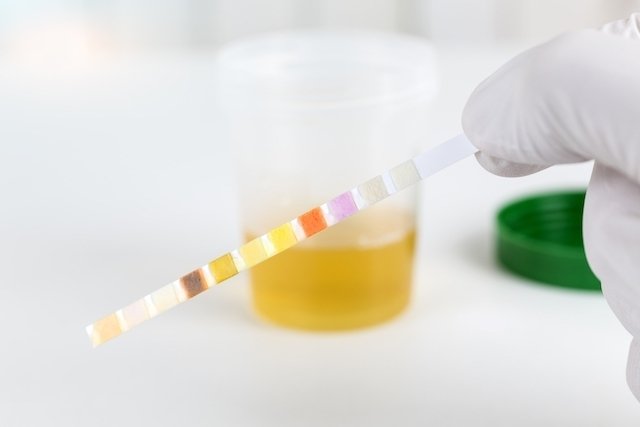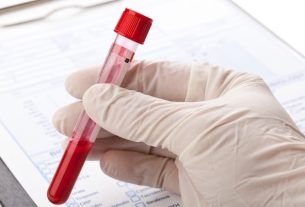The urine test, also known as type 1 urine test or EAS test (Abnormal Sediment Elements), is a test normally requested by doctors to identify changes in the urinary and renal system and should be done by analyzing the first urine of the day, since it is more concentrated.
Urine collection for the test can be done at home and does not require fasting, but it must be taken to the laboratory within 2 hours for analysis. The type 1 urine test is one of the tests most requested by doctors, as it informs several aspects of the person’s health, in addition to being quite simple and painless.
In addition to the EAS, there are other tests that evaluate urine, such as the 24-hour urine test and the urine test and culture, in which urine is analyzed with the aim of identifying the presence of bacteria or fungi.

What is the EAS exam for?
The EAS exam is requested by the doctor to evaluate the urinary and renal system, being useful for identifying urinary infections and kidney problems, such as kidney stones and kidney failure, for example. Thus, the EAS exam serves to analyze some physical and chemical aspects and the presence of abnormal elements in the urine, such as:
- Physical aspects: color, density and appearance;
- Chemical aspects: pH, nitrites, glucose, proteins, ketones, bilirubin and urobilinogen;
- Abnormal elements: blood, bacteria, fungi, protozoa, sperm, mucus filaments, cylinders and crystals.
Furthermore, the urine test checks the presence and quantity of leukocytes and epithelial cells in the urine.
The urine test can be collected in the laboratory or at home and the first urine of the morning must be collected, discarding the first stream. Before collecting, it is important to clean the intimate area with soap and water to prevent contamination of the sample. After collecting the urine, the container must be taken to the laboratory within 2 hours for analysis to be carried out.
24-hour urine test
The 24-hour urine test helps identify small changes in urine throughout the day and is done by accumulating all the urine eliminated during the day in a large container. This sample is then taken to the laboratory and analyzes are carried out to check its composition and quantity, helping to identify changes such as kidney filtration problems, protein loss and even pre-eclampsia during pregnancy. Learn more about the 24-hour urine test.
Type 1 urine test reference values
Type 1 urinalysis reference values should be:
- pH: 5,5 e 7,5;
- Density: from 1,005 to 1,030
- Characteristics: Absence of glucose, proteins, ketones, bilirubin, urobilinogen, blood and nitrite, some (few) leukocytes and rare epithelial cells.
If the urine test reveals positive nitrite, the presence of blood and numerous leukocytes, for example, it may be indicative of a urinary infection, but only the urine culture test can confirm the presence or absence of infection. However, the type 1 urine test should not be used alone to diagnose a urinary problem. Understand what urine culture is and how it is done.
Ascorbic acid in urine
The amount of ascorbic acid in the urine (vitamin C) is also normally measured with the aim of checking whether or not there was any interference in the results of hemoglobin, glucose, nitrites, bilirubin and ketones, for example.
The increased amount of ascorbic acid in the urine may be due to the use of vitamin C medications or supplements or excessive consumption of foods rich in vitamin C.
How to prepare for the urine test
Generally, no special care is needed before taking a urinalysis, however some doctors may ask you to avoid using vitamin C supplements, anthraquinone laxatives or antibiotics, such as Metronidazole, a few days beforehand, as may change the results.
It is also important to collect urine correctly, as collecting the first stream or a lack of correct hygiene can lead to results that do not reflect the patient’s condition. Furthermore, it is not recommended that women perform a urine test during their menstrual period, as the results may be altered.
Urine test to detect pregnancy
There is a urine test that detects pregnancy through the amount of hCG hormone in the urine. This exam is reliable, however when the test is done too early or incorrectly the result can be wrong. The ideal time for this test to be done is 1 day after the day on which menstruation should have appeared, and it should be done using the first urine in the morning, as this hormone is more concentrated in the urine.
Even when the test is carried out at the right time, the result may be false negative because the body may not yet have produced the hCG hormone in sufficient quantities to be detected. In this case, a new test must be done after 1 week. This urine test is specific to detect pregnancy, therefore other urine tests such as the type 1 urine test or urine culture, for example, do not detect pregnancy.

Sign up for our newsletter and stay up to date with exclusive news
that can transform your routine!
Warning: Undefined array key "title" in /home/storelat/public_html/wp-content/plugins/link-whisper-premium/templates/frontend/related-posts.php on line 12
Warning: Undefined array key "title_tag" in /home/storelat/public_html/wp-content/plugins/link-whisper-premium/templates/frontend/related-posts.php on line 13



